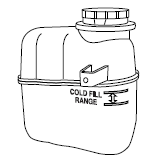Checking engine coolant

The concentration and level of engine coolant should be checked at the intervals listed in scheduled maintenance information. The coolant concentration should be maintained at 50/50 coolant and distilled water.
For best results, coolant concentration should be tested with a refractometer such as Rotunda tool 300-ROB75240E available from your dealer. Ford does not recommend the use of hydrometers or coolant test strips for measuring coolant concentration. The level of coolant should be maintained at the FULL COLD level or within the COLD FILL RANGE in the coolant reservoir. If the level falls below, add coolant per the instructions in the Adding engine coolant section.
Your vehicle was factory-filled with a 50/50 engine coolant and water concentration. If the concentration of coolant falls below 40% or above 60%, the engine parts could become damaged or not work properly. A 50/50 mixture of coolant and water provides the following:
Х Improved freeze protection.
Х Improved boiling protection.
Х Protection against rust and other forms of corrosion.
Х Proper function of calibrated gauges.
When the engine is cold, check the level of the engine coolant in the reservoir.

Х The engine coolant should be at the FULL COLD level, or within the
COLD FILL or MIN / MAX range as listed on the engine coolant
reservoir (depending upon application).
Х Refer to scheduled maintenance information for service interval
schedules.
If the engine coolant has not been checked at the recommended interval, the engine coolant reservoir may become low or empty. If the reservoir is low or empty, add engine coolant to the reservoir. Refer to Adding engine coolant in this chapter.
Note: Automotive fluids are not interchangeable; do not use engine coolant/antifreeze or windshield washer fluid outside of its specified function and vehicle location.
See also:
Important supplemental restraint system precautions
Airbags DO NOT inflate slowly or
gently and the risk of injury from a
deploying airbag is greatest close to
the trim covering the airbag module.
WARNING: All occupants of the vehicle, includi ...
Window lock
The window lock feature allows only
the driver to operate the power
windows.
To lock out all the window controls
(except for the driverТs) press the
right side of the control. Press the
l ...
Overview
Better handling, increased power, improved fuel efficiency, additional
standard equipment, more refinement and new technologies that help drivers
reduce accident risks provide luxury customers with ...
